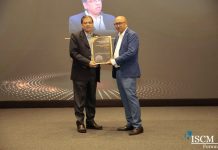As solar power is poised to explode in the coming decade, a slew of exciting technologies is emerging out of labs to create the 3rd generation of photovoltaic cells, which are cheaper and easier to fabricate. Underlying these cells are some very complex chemistries shaped by high performance molecules. A striking feature of these thin-film solar cells is their flexibility which allows them to be integrated with various other products
In its report late last year, the International Energy Agency (IEA) declared that photovoltaic power has become cheapest ever in history. Yet, its share in the contribution of global electricity generation is a measly 2%. But solar power is tipped to grow at a frenetic pace this decade and together with wind is likely to knock coal off its pedestal as the most dominant energy resource for electricity production.
Bulk of the photovoltaic cells today are based on silicon. There are two main reasons why we need to look beyond silicon for our photovoltaic power in this decade. Firstly, the efficiency of silicon cells has peaked and is currently very close to the theoretical maximum stipulated by the Shockley- Queisser limit of 30%. Secondly, silicon production and purification are extremely energy intensive. Energy Payback Time (EPBT) is a good metric of sustainability and is defined as the time taken for an energy device to generate the amount of energy equivalent to that required for its manufacture. EPBT of silicon solar cells range between 2 to 3 years.
There are quite a few contenders to replace silicon as the key constituent in the third generation photovoltaic cells. Among them are perovskite solar cell, organic solar cell, dye-sensitised solar cell and quantum dots.
OPV Cells
Organic Solar Cells, commonly known as OPV (Organic Photovoltaic) cells are flexible, lightweight and cheaper and easier to fabricate. Their efficiency is currently low, but still their EPBT is estimated to be of the order of few months, compared to 2-3 years for silicon cells. Earlier this year, researchers claimed to have realised a record efficiency of 18% from an OPV cell. OPV cells are typically fabricated by spraying or coating the active substances on to a rigid or flexible substrate. The active layer of an OPV cell is a mixture of electron donor (a material with low ioinisation energy) and an electron acceptor (a material with high electron affinity).
The earliest electron acceptors in OPV cells were derivatives of Fullerene, the molecule with 60 carbon atoms, that was discovered in 1985 earning a Nobel Prize for its 3 discoverers in 1996. But Fullerene derivatives had serious limitations which prevented the OPV cells from achieving commercially viable efficiencies. This kick-started a major research programme resulting in the development of a class of non-Fullerene acceptors termed as Fused Ring Electron Acceptors (FREA). The benchmark molecule of FREA was synthesised in 2015 and is popularly known as ITIC with the chemical formula of C94H82N4O2S4. It opened the floodgates for a second generation of more efficient non-Fullerene OPV cells. These new class of OPV cells not only have higher efficiency, but better thermal and photochemical stability and improved longevity. There is a huge number of potential electron acceptors in the FREA family that can deliver even better performance. Scientists are now resorting to machine-learning models to sift through the impossibly large number of candidates and come up with high performance molecules to build more efficient OPV cells.
DSSC
Dye-Sensitised Solar Cells (DSSC), also known as Grätzel Cells after the Swiss chemist Michael Grätzel, who did pioneering work on their development, can operate under varied lighting conditions including low and diffused light. They are thus ideal for indoor applications. DSSC use a redox electrolyte sandwiched between two transparent semiconductor electrodes. Dye molecules, absorbed as a monolayer to the back of one of the electrodes, are excited by light and inject electrons into the conduction band of the electrode. The dye is restored to its original state by the redox electrolyte. Electrons moving through the external circuit reduce the oxidised redox agent of the electrolyte at the opposite electrode to complete the cycle. Polypyridine complexes of Ruthenium were the first dyes to be extensively studied in DSSC.
Metallo-porphyrins and metallophthalocyanines are other dyes investigated. Typical efficiency of these cells range between 10% to 14%. The current thrust of research is to develop greener and more sustainable alternatives of the many components that go into the making of the DSSC, in addition to improving the efficiency numbers.
Perovskites
Among the various emerging alternatives to silicon, none is more exciting than Perovskites. A perovskite coated silicon cell could hit the market as early as first quarter of 2022. Perovskite was originally a mineral discovered in the Ural Mountains of Russia in 1839 and named after the Russian mineralogist, Lev Perovski. Today it is synthesised in the laboratories and refers to a class of materials that have the same crystal structure as Calcium Titanate, the original mineral. A typical Perovskite structure is ABX3, where A is an organic cation, B is a metal (usually lead) and X is a halide anion. The most widely studied perovskite today is methylammonium lead iodide. Recently, a start-up spawned by Oxford University, announced a record-breaking efficiency of 29.5% for a solar cell, compared to 15-25% for today’s commercial cells. This feat was accomplished by coating the silicon cells with a thin film of perovskite. The higher efficiency is due to the fact that the coated cells are able to absorb more of solar radiation. The thin perovskite layer absorbs shorter wavelengths and silicon absorbs the longer ones. Perovskite can also be used on a stand-alone basis as a thin-film cell and this has exciting possibilities. A solution of perovskite can be spray coated on virtually any surface turning it into a potential power generator.
Quantum Dots
Quantum Dots (QD) are nanostructures imbued with many interesting properties depending upon the material and shape. One of their myriad applications is deployment in solar cells. A decade ago, the efficiency of a QD solar cell was less than 3%. But continuous improvement over the decade has transformed QD Cell from a laboratory curiosity to commercially exciting prospect. Earlier QD cells were made from toxic heavy metals like cadmium and selenium. Researchers are now engaged in developing environmentally more benign alternatives, in addition to optimising the size and density of the Quantum Dots.
Epilogue
Third Generation photovoltaic cells are characterised by ease of fabrication and low environmental footprint. Their EPBT is significantly lower than that of silicon cells. They are lightweight, flexible and cheaper. The flexibility allows them to be incorporated into many different products. They can be rolled up or folded up. They can be coated on windows or painted on façade of buildings, turning them into power generators.It is even possible to have these solar cells on the apparel we wear. The impressive efficiencies chalked up by these cells today are limited to laboratories and much work needs to be done before they are rolled out commercially. Their robustness in real world situations of temperature and humidity has to be established if they can compete with silicon cells which have a proven longevity of 25 years and more. Underlying the many competing technologies of the third generation photovoltaic cells are complex chemistries, greatly shaped by material properties and characteristics. Much fundamental research at molecular level is underway in laboratories across the globe as start-ups flush with funds from green investors are competing with each other to be the first to enter the huge market. The race to capture sunlight and the market is heating up.
Readers’ responses may be sent to:
k.sahasranaman@gmail.com or
chemindigest@gmail.com

































